Introduction
In a world increasingly driven by data, organizations are tasked with navigating the complexities of analytics to unlock transformative insights. The four core types of analytics—Descriptive, Diagnostic, Predictive, and Prescriptive—serve as essential pillars in this journey, empowering businesses to make informed decisions that enhance operational efficiency and strategic planning.
As companies integrate these analytics with Robotic Process Automation (RPA) and Business Intelligence (BI), they position themselves to tackle challenges more effectively, streamline processes, and gain a competitive edge. This article delves into the significance of each analytics type, their real-world applications across various industries, and the future trends that promise to reshape how organizations leverage data for success.
By understanding and implementing these analytics strategies, businesses can not only thrive in a data-driven landscape but also pave the way for innovation and growth in the years to come.
Exploring the Core Types of Analytics: Descriptive, Diagnostic, Predictive, and Prescriptive
Analytics is a powerful tool that can be broadly categorized into four distinct types, including a different type of analytics, which are Descriptive, Diagnostic, Predictive, and Prescriptive. Each of these plays a crucial role in helping organizations leverage information effectively, especially when complemented by Robotic Process Automation (RPA) and business intelligence strategies.
-
Descriptive Analytics: This foundational type focuses on summarizing historical information to illuminate what has transpired in the past. By employing information aggregation and mining techniques, descriptive analytics offers valuable insights into trends and patterns. For instance, a retail company may examine last year’s sales figures to pinpoint peak sales periods, thereby informing future marketing strategies. RPA can automate the information collection process, ensuring that the information is aggregated efficiently and accurately. The impact of descriptive analysis on business performance can be profound, as it allows organizations to make data-driven decisions that reflect their historical performance and enhances operational efficiency when integrated with RPA.
-
Diagnostic Analysis: Building upon the insights provided by descriptive analysis, diagnostic analysis seeks to uncover the reasons behind certain events. It utilizes techniques such as information discovery and correlation analysis to dig deeper into the information and reveal the underlying causes of performance outcomes. For example, if a company experiences a sales decline in a specific quarter, diagnostic analysis can help identify factors such as market fluctuations or operational challenges that contributed to this drop. RPA can streamline the discovery process by automating the extraction and correlation of relevant information, making it easier to identify issues. Grasping diagnostic analysis becomes essential for tackling challenges, especially as entities encounter obstacles to effective analysis use—such as poor master data quality and limited access to comprehensive information—often worsened by the complexity of the AI landscape.
-
Predictive Analysis: This forward-looking type utilizes statistical models and machine learning techniques to predict future outcomes based on historical data. Predictive analysis empowers organizations by enabling them to anticipate trends and behaviors, facilitating proactive decision-making. For instance, a retail business might utilize predictive data analysis to project inventory needs based on seasonal trends and customer purchasing behavior, thereby optimizing stock levels and reducing costs. RPA can assist in automating updates and model retraining, ensuring that predictions are based on the most current information. Furthermore, approximately 1,400 universities are utilizing predictive analysis to help tackle low graduation rates, demonstrating the practical application of this type of analysis in the education sector, and highlighting the necessity for a strong information strategy that includes RPA to enhance information collection and processing.
-
Prescriptive Analysis: As the most advanced type, prescriptive analysis goes a step further by recommending specific actions to achieve desired outcomes. It merges information analysis with business rules and algorithms to propose optimal strategies for decision-makers. For example, a logistics company could use prescriptive data analysis to determine the best delivery routes, taking into account real-time traffic patterns and customer delivery windows. RPA can improve the efficiency of prescriptive insights by automating the information feeds necessary for real-time decision-making, thereby ensuring that suggestions are based on the most recent information.
Understanding these core types of insights, along with the strategic integration of RPA and business intelligence, equips entities to better align their information strategies with operational goals, ultimately enhancing effectiveness and informed decision-making by utilizing a different type of analytics. Key sectors gaining advantages from large information include finance, healthcare, retail, manufacturing, and transportation, highlighting the importance of analysis across multiple industries. As we approach 2024, trends indicate a growing dependence on these types of analysis, with many entities acknowledging their essential role in gaining a competitive edge in a data-driven environment.
Nevertheless, entities must also tackle obstacles like inadequate primary information quality and hindrances to AI implementation to fully utilize these analytical capabilities.
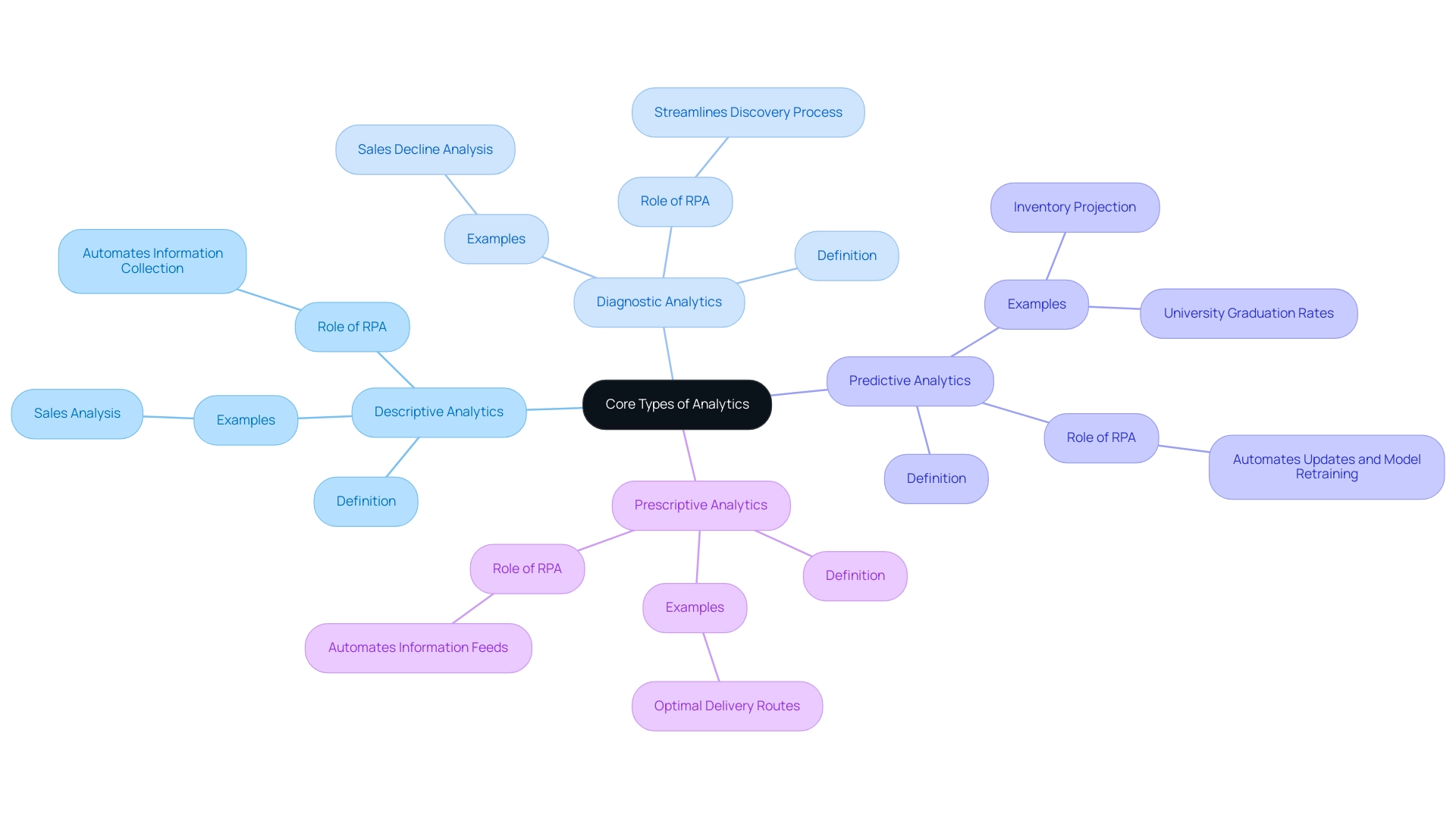
The Importance of Different Analytics Types in Business Decision-Making
In today’s data-driven landscape, different types of analytics are integral to enhancing business decision-making processes, significantly supported by Robotic Process Automation (RPA) and tailored AI solutions.
-
Descriptive Analytics serves as a foundational element, offering historical context essential for understanding past performances and establishing benchmarks. By analyzing trends and patterns, companies can utilize a different type of analytics through RPA to automate data collection processes, empowering them to make informed decisions that shape future strategies while potentially lowering operational costs.
-
Diagnostic Analytics plays a crucial role in pinpointing the root causes of challenges. Coupled with RPA, it provides entities with the insights needed to address issues effectively, ultimately refining processes and boosting operational efficiency. This analytical approach sheds light on what went wrong and why, enabling targeted improvements through a different type of analytics. Additionally, predictive analytics allows businesses to look ahead, anticipating future trends and fostering a proactive rather than reactive approach. By integrating tailored AI solutions, companies can gain strategic advantages through different types of analytics, such as optimized inventory management, targeted marketing initiatives, and enhanced customer satisfaction. A noteworthy statistic reveals that leading marketers are 1.6 times more likely to believe that open information access contributes to superior performance, further showcasing the value of predictive insights.
-
Prescriptive Analytics elevates decision-making by recommending specific actions derived from analysis. This not only streamlines operations but also enhances strategic planning, providing organizations with clear pathways toward achieving their objectives. With 54% of companies considering the incorporation of cloud computing and business intelligence into their analytical strategies, as highlighted by industry leaders, the potential for transformative outcomes is immense.
Business Intelligence serves as a critical tool in this landscape by employing different types of analytics to transform raw data into actionable insights that drive informed decision-making and operational efficiency. As we near 2024, the significance of data analysis in business decision-making becomes increasingly clear. Data-driven methods are expected to surpass intuition in 65% of B2B sales firms by 2026, indicating a significant shift towards dependence on data analysis in sales approaches.
The case study titled ‘B2B Sales Entities and Data-Driven Strategies’ illustrates this trend, highlighting how firms that leverage data-driven insights, enhanced by RPA and Business Intelligence, are better positioned to improve operational efficiency and innovation while reducing costs. By grasping and efficiently utilizing this different type of analytics, entities can transform their decision-making procedures, leading to improved operational effectiveness, lowered expenses, and notable innovation. The insights gathered from these practices not only improve overall performance but also position businesses to thrive in a competitive marketplace.
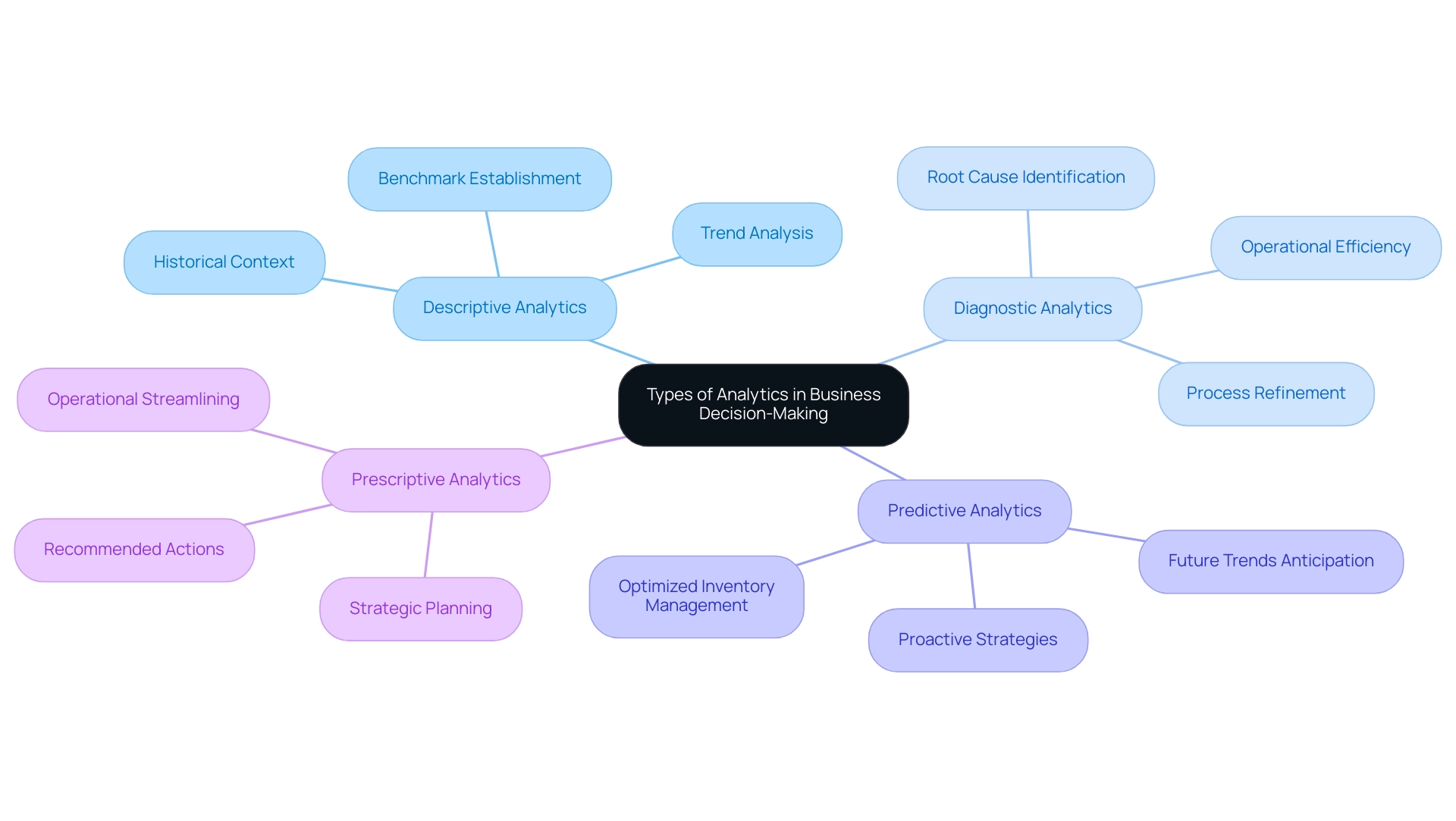
Real-World Applications of Analytics in Various Industries
Analysis plays a crucial role across numerous sectors, enabling organizations to utilize information for improved operations and strategic decision-making, particularly when paired with technologies such as Robotic Process Automation (RPA) and Business Intelligence (BI).
-
Healthcare: Predictive analysis, supported by RPA, is transforming the healthcare sector by anticipating patient admissions. Hospitals utilize historical information, including electronic health records (EHR) and electronic medical records (EMR), to anticipate peak admission times, optimizing staffing and resource allocation. This proactive approach not only improves operational efficiency but also enhances patient care quality, ensuring resources are available when needed most. As the healthcare sector progresses, it is anticipated that 30% of the information produced will be available in real time by 2025, further improving the capabilities of healthcare analysis.
-
Retail: Retailers are increasingly adopting descriptive analysis, alongside RPA tools, to gain insights into customer purchasing behaviors. By meticulously analyzing sales information, they can pinpoint products that surge in popularity during specific seasons. This knowledge allows for more effective inventory management, reducing excess stock and ensuring that popular items are readily available for customers, ultimately driving sales growth. The automation of these processes through RPA also reduces manual, repetitive tasks, leading to significant time savings.
-
Finance: In the financial sector, diagnostic analysis is crucial for identifying fraudulent transactions. By scrutinizing transaction patterns and anomalies, financial institutions can detect unusual behaviors that may indicate fraud. Integrating RPA in these processes enables faster information processing and enhances the capabilities of proactive risk management, safeguarding assets and maintaining customer trust. Additionally, the implementation of RPA can lead to substantial cost savings by streamlining operations and reducing the need for manual oversight.
-
Manufacturing: The manufacturing sector utilizes prescriptive data analysis, supported by RPA, to fine-tune production schedules. By examining machine performance information, manufacturers can ascertain optimal operation times for specific machinery. This approach minimizes downtime and maximizes productivity, leading to improved operational efficiency. Furthermore, the use of RPA in this context aids in removing repetitive tasks, enabling personnel to concentrate on more strategic initiatives.
These examples highlight the flexibility of data analysis, illustrating how customized solutions, including RPA and BI, can tackle the unique challenges encountered by different sectors using different types of analytics. According to an analysis conducted by Allied Market Research in 2019, the market value of large information in North America is expected to reach $34.16 billion by 2025. With the projected expansion of large information sets, expected to rise from 33 ZB in 2018 to 175 ZB by 2025, entities that adopt analysis tools, complemented by RPA and BI, will be well-positioned to harness the potential of Business Intelligence, converting raw information into actionable insights that drive informed decision-making and operational excellence.
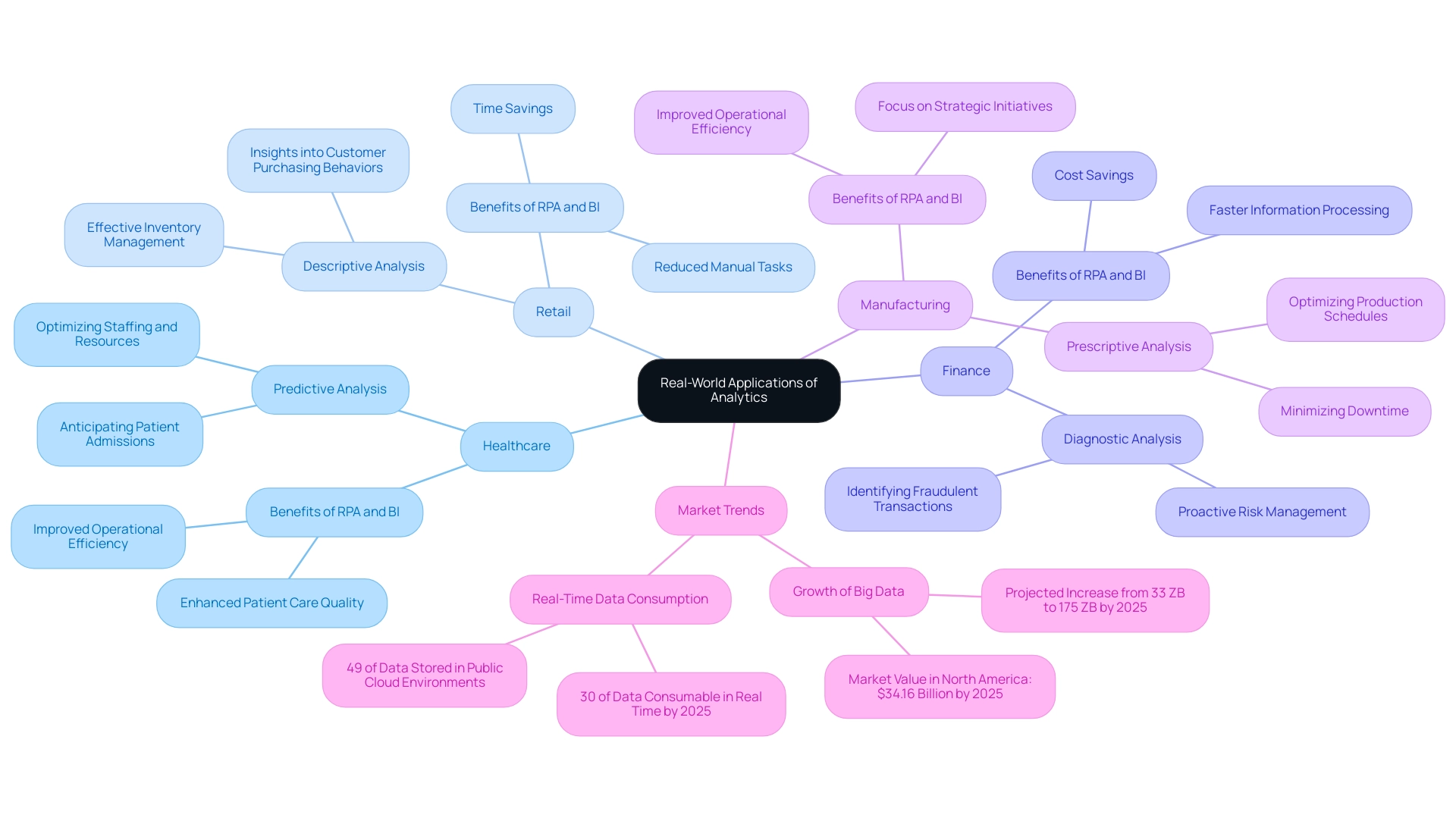
Challenges in Implementing Analytics Solutions
While the potential advantages of different types of analytics are substantial, organizations often face significant hurdles during implementation. A key concern is the quality of information; inaccurate or incomplete information can yield misleading insights when analyzed using a different type of analytics. As a result, it is essential for companies to invest in thorough information cleansing and validation procedures to ensure the reliability of their analysis outputs.
Statistics suggest that 57% of companies that prioritize information quality report improved decision-making effectiveness, highlighting its significance in the analytical process.
Integration poses another challenge, as seamlessly connecting existing systems with different types of analytics tools can be intricate. Organizations must ensure their analysis solutions are compatible with current information infrastructures to maintain an effective information flow. This complexity is further heightened by the rapid growth of different types of analytics, including:
- augmented insights
- edge insights
- data democratization
- DaaS
- synthetic data generation
These are key trends in data analysis for 2024.
North America led the augmented data analysis market in 2023 with a valuation of $3.03 billion due to heightened digital adoption and competitive pressures.
To enhance operational efficiency, businesses can explore Robotic Process Automation (RPA) to streamline repetitive tasks, allowing teams to focus on higher-value work. Furthermore, tailored AI solutions can specifically address organizational challenges, ensuring that technology adoption aligns with business goals. For instance, implementing customized AI models can help in automating customer interactions, thereby improving service delivery and operational efficiency.
Practical training is crucial in this context; companies should invest in workshops that equip their teams with the skills necessary to implement and manage these AI solutions effectively. Such training can focus on real-world applications and best practices, including the use of a different type of analytics like ChatGPT 4.0, to ensure that employees are well-prepared to leverage AI tools.
Change management is also critical; employee resistance can obstruct the adoption of a different type of analytics solutions. To cultivate a culture that embraces data-driven decision-making, companies should concentrate on offering comprehensive training and ongoing support through workshops centered on different types of analytics, including AI integration strategies and ethical practices.
According to Naresh Kumar, Lead Marketing Strategist, enterprises must implement a concrete, cohesive information integration strategy to break down these barriers and create a unified information ecosystem to drive informed decision-making.
Additionally, organizations may encounter skill gaps, as there often exists a shortage of qualified personnel capable of effectively analyzing and interpreting different types of analytics. Investing in training programs or employing specialists can bridge this gap, enabling teams to utilize a different type of analytics to maximize their potential.
A relevant case study titled “Scalability and Performance in Data Analytics” illustrates these challenges. As information volumes rise, companies encounter challenges in ensuring their analytical framework can manage the requirements for storing, processing, and examining large datasets with different types of analytics. Failure to scale can lead to an inability to generate critical business reports.
By performing a 360-degree evaluation of current information systems, Zuci identifies issues and formulates strategies for enhancement, ensuring the infrastructure can handle increasing volumes of information.
By proactively addressing these challenges and utilizing Business Intelligence, entities can significantly improve their ability to implement a different type of analytics successfully, thereby maximizing the advantages of data-driven decision-making.
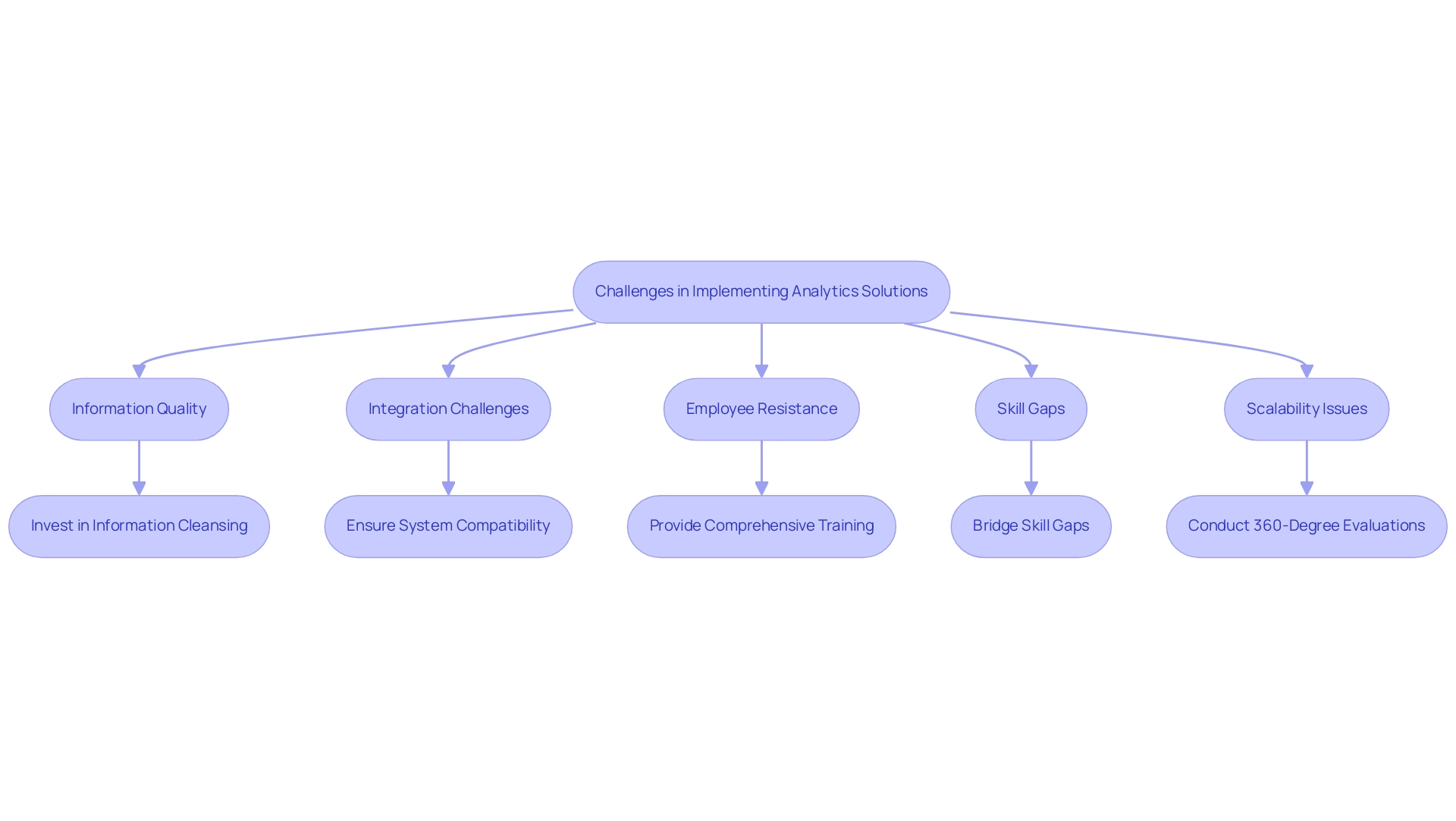
Future Trends in Analytics
The landscape of analytics is swiftly changing, with several key trends ready to reshape how entities utilize information for strategic advantage:
-
Artificial Intelligence and Machine Learning: The incorporation of AI and machine learning into analytics is anticipated to quicken, paving the way for more advanced information analysis and predictive modeling. These advanced technologies are not only automating processing but also enhancing the depth of insights derived from complex datasets. Furthermore, tailored AI solutions can assist entities in navigating the overwhelming AI landscape, ensuring alignment with specific business goals. Gartner forecasts that by 2027, over half of Chief Data and Analytics Officers (CDAOs) will obtain funding for information literacy and AI literacy initiatives, driven by business shortcomings in achieving anticipated value from generative AI, as mentioned by Ramakrishnan.
-
Real-Time Insights: The need for real-time insights is rising, allowing entities to make rapid, informed choices based on the latest information available. This trend is especially critical in sectors such as finance and e-commerce, where timely insights can create significant competitive advantages. As companies adjust, the anticipation is that real-time insights will become standard practice, enabling agile reactions to market changes, further improved by RPA to automate information workflows and simplify processes.
-
Information Democratization: Firms are increasingly prioritizing information democratization, concentrating on making insight tools accessible to non-technical users. By simplifying these tools and offering thorough training, businesses enable a wider variety of employees to integrate information into their decision-making processes. This shift not only improves overall operational efficiency but also promotes a culture driven by information throughout the entity, supported by RPA to lessen the burden of manual tasks.
-
Enhanced Information Privacy: With increasing concerns over information privacy, entities must prioritize strong information governance and compliance in their analysis strategies. Implementing stringent security measures to protect sensitive information is essential while still extracting valuable insights. As 60% of the information utilized by AI and analytical solutions is anticipated to be synthetic by year-end, ensuring integrity and privacy becomes increasingly paramount.
-
Business Intelligence: Leveraging Business Intelligence is crucial for transforming raw information into actionable insights. This process enables entities to make informed decisions that drive growth and innovation. By incorporating BI tools, businesses can illustrate trends, recognize opportunities, and improve operational efficiency, ultimately aiding strategic goals.
Understanding these trends is crucial for entities seeking to utilize a different type of analytics to drive future growth and innovation. The expected 35% rise in demand for sustainability-enabled monitoring services, as emphasized by research from the University of California, illustrates the increasing convergence of data analysis and responsible resource management. As organizations tend to expand their analytics departments when they reach 500 employees, staying ahead of these trends allows them to harness analytics not merely as a tool, but as a strategic asset for long-term success, supported by RPA and Business Intelligence for informed decision-making.
Specific examples of RPA’s impact include automating data entry and reporting tasks, which significantly reduce manual workloads and enhance overall efficiency.
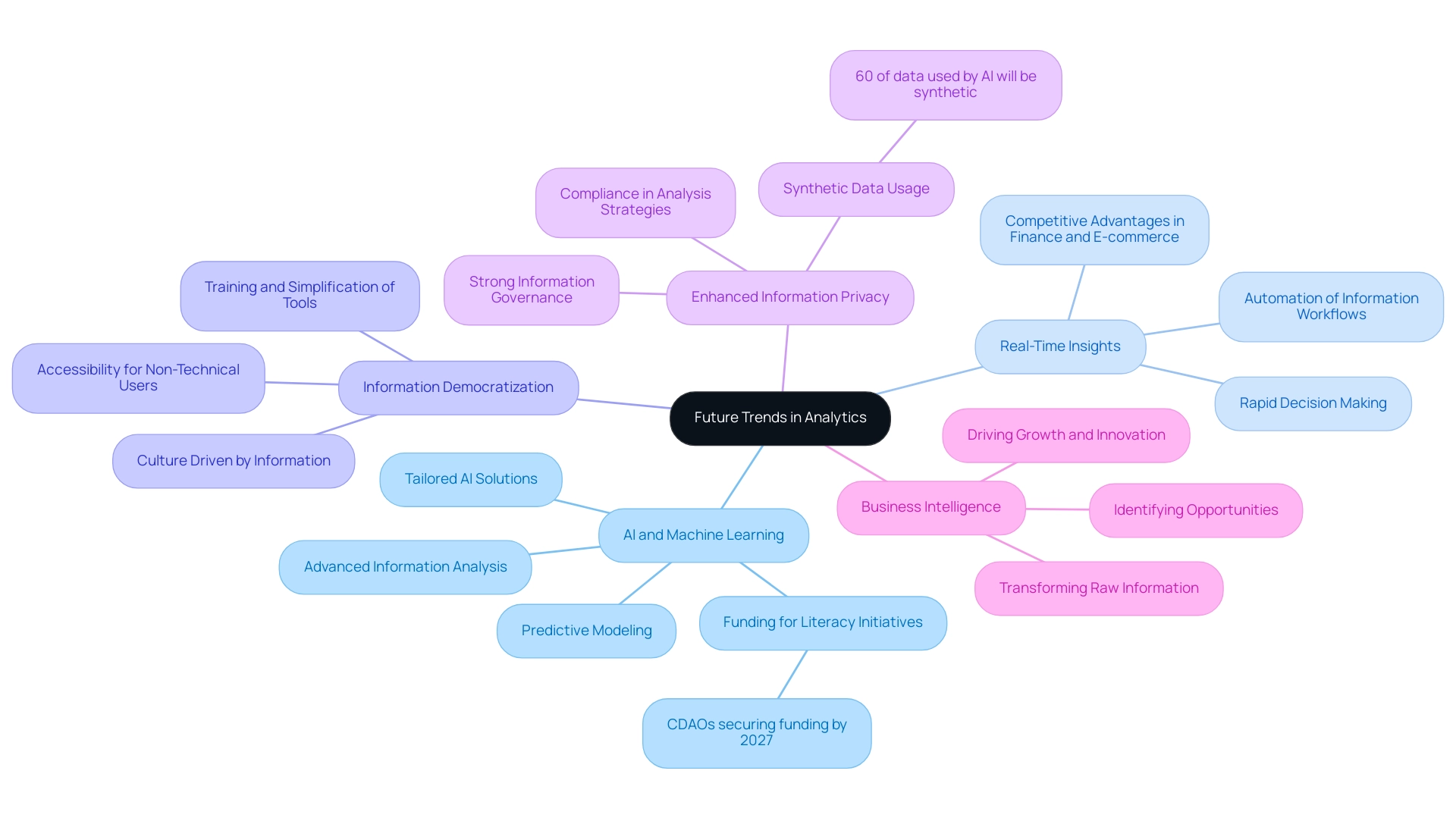
Conclusion
Organizations today stand at the forefront of a data revolution, with the four core types of analytics—Descriptive, Diagnostic, Predictive, and Prescriptive—serving as vital tools for navigating this landscape. By embracing these analytics, businesses can unlock insights that inform decision-making, streamline operations, and ultimately drive growth. The integration of Robotic Process Automation (RPA) and Business Intelligence (BI) amplifies these benefits, enabling companies to respond swiftly to market demands and enhance operational efficiency.
Real-world applications across diverse sectors, from healthcare to finance, demonstrate the transformative impact of analytics. Predictive analytics anticipates trends, while prescriptive analytics offers actionable recommendations, ensuring organizations are well-equipped to tackle challenges head-on. However, successful implementation requires addressing barriers such as data quality and integration complexities. Investing in comprehensive training and fostering a culture of data literacy will empower teams to leverage these technologies effectively.
Looking ahead, the future of analytics is bright, with emerging trends like real-time analytics and data democratization paving the way for even greater innovation. As organizations continue to adapt and evolve, those that prioritize analytics as a strategic asset will not only enhance their operational capabilities but also secure a competitive edge in an increasingly data-driven world. By embracing these analytics strategies today, businesses can position themselves for sustained success and growth in the years to come.

